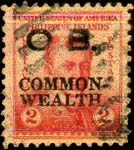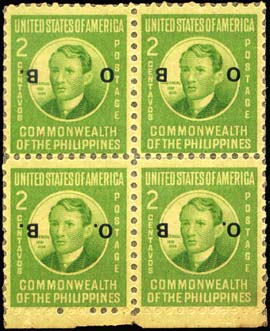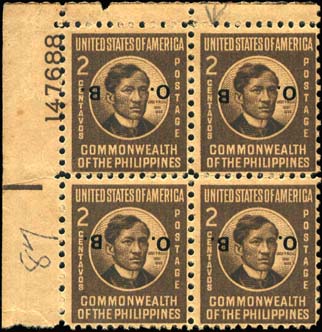| An executive order, issued by C.M. Cotterman, Director of Posts, stated,
in part "Commencing January 1, 1906, all official mail of the insular,
provincial and municipal governments, must be fully prepaid by the sending
office or officer."
In paragraph three of the same order, we find the following "Officers
purchasing stamps for government business may, if they so desire, surcharge
them with the letters "O.B." either in writing in black ink or by rubber
stamp." (Today this is classified as an "overprint" not a "surcharge").
This executive order was generally followed, except that any color of ink
that was handy was used.
The Philippine Constabulary, requested and received stamps overprinted
by the Bureau of Printing in May of 1907. The Director of the Philippine
Constabulary, at that time, was Gen. H.H. Bandholtz, who ordered the overprinted
stamps. They are printed in a distinct style and in five colors, black,
blue, green, red and yellow. Today they are known as the "Bandholtz Official
Overprints". Neither the Bureau of Printing nor the Bureau of Posts were
authorized to retain any of these overprints and they were inundated with
requests from collectors and dealers for these stamps, which they could
not supply. After the second printing, in July of 1907, requests for stamps
made to the Constabulary Administrative Officer were honored.
In 1926 the Bureau of Printing resumed overprinting stamps for official
use, and in 1931 adopted the Black Block "O.B." overprint, This overprint
was made available to any government office who wished to purchase them.
The Bureau of Posts also sold "O.B."s to collectors at the philatelic window
of the Manila Post Office.
Collectors were quick to notice that an error occurred on some of the
"O.B." overprints, some copies had periods missing. Local forgers saw a
gold mine and started to manufacture this error by removing the period.
The bureau of Posts countered this practice by not correcting the printing
plates, thereby creating a sufficient supply to meet the demands of collectors
and not create a rarity.
This procedure for overprinting official stamps continued into the Republic
era. During the Japanese occupation the "O.B." was replaced with kanji.

|

|
Fig. 3.1: Genuine "O.B." Overprint
With Missing Period After "B"
a
|
Fig. 3.2: Forged Missing Period Error
Stamp surface softened, possibly with
bleach and period after "O" scraped.
|

|

|
Fig. 3.3: Genuine "O.B." Overprint
Dull black with serifed "B".
Oval "O" and periods after "O" and "B".
Length: 14.25 mm. Height: 2.5 mm
|
Fig. 3.4: Genuine "O.B." Overprint
Dull black with serifed "B".
Oval "O" and periods after "O" and "B".
Length: 14 mm. Height: 3.5 mm
|

|

|
Fig. 3.5: "Recto" Forgery
Shiny black color in sans serif upper case characters.
Rounder "O" and squares after "O" and "B".
Length: 15.2 mm. Height: 2.3 mm.
|
Fig. 3.6: "Recto" Forgery
Shiny black color in sans serif upper case characters.
Rounder "O" and squares after "O" and "B".
Length: 14.25 mm. Height: 3.0 mm.
|
Die used on Fig. 3.6 also used on Rizal green "O.B.".
Note: Figure 3.2 image reproduced
from colored photocopy.
|

